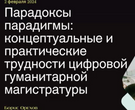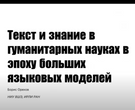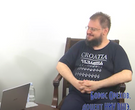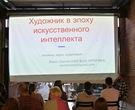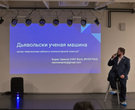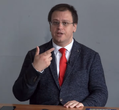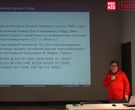- A
- A
- A
- АБB
- АБB
- АБB
- А
- А
- А
- А
- А
- Национальный исследовательский университет «Высшая школа экономики»
- Факультет гуманитарных наук
- Школа лингвистики
- Новости
- В.Ю. Апресян выступила на конференции "Metaphor in the 21 century: New Cognitive Domains", проходившей 3-4 декабря в Костельон де ла Плана, Испания, с докладом "Metaphor in Grammar: Mapping across syntactic domains"
-
Школа
- О школе
- Сотрудники
- Семинары
-
Исследовательские подразделения
-
- Международная лаборатория языковой конвергенции
- Центр «Русский как иностранный»
- Центр цифровых гуманитарных исследований
- Центр языка и мозга
- Лаборатория по формальным моделям в лингвистике
- Лаборатория «Корпусные исследования»
- Лаборатория языков Кавказа
- Лаборатория учебных корпусов
- Лаборатория теоретической и полевой фольклористики
- Лаборатория социогуманитарных исследований Севера и Арктики
-
-
Проекты
-
Проекты сотрудников
-
Проекты студентов и аспирантов
-
Завершённые проекты
- Некомпозициональные конструкции в эритажном русском
- Компьютерные и лингвистические ресурсы для поддержки шугнанского языка
- Лингвоспецифическая разметка китайских текстов в Русско-китайском параллельном корпусе НКРЯ
- Цифровой архив: создание корпуса журнала "Отечественные записки"
- Создание лингвокультурологического подкаста о России для иностранцев «Yellow Blue Bus» (Я люблю вас)
- База данных русских идиом
- Компьютерные и корпусные инструменты для иранистических исследований
- Русский разговорный клуб
- Шугнанские глаголы в типологическом освещении
- Создание академического онлайн-словаря персидского языка
-
- Международное сотрудничество
- Экспедиции
- Ресурсы
- Препринты
- Наша книжная полка
-
Образовательные программы
- Бакалаврская программа «Фундаментальная и компьютерная лингвистика»
- Магистерская программа «Компьютерная лингвистика»
- Магистерская программа «Лингвистическая теория и описание языка»
- Магистерская программа «Русский как иностранный во взаимодействии языков и культур»
- Магистерская программа «Цифровые методы в гуманитарных науках»
- Аспирантская школа по филологическим наукам
Адрес: 105066, г. Москва,
Старая Басманная ул., д. 21/4
Телефон: +7 (495) 772-95-90 доб. 22734
E-mail: ling@hse.ru
Редакторы сайта — Наталья Борисовна Пименова, Максим Олегович Бажуков, Константин Евгеньевич Сатдаров
- Международная лаборатория языковой конвергенции
- Лаборатория «Корпусные исследования»
- Лаборатория по формальным моделям в лингвистике
- Лаборатория языков Кавказа
- Лаборатория социогуманитарных исследований Севера и Арктики
- Научно-учебная лаборатория учебных корпусов
- Центр «Русский как иностранный»
- Научно-учебные группы
- Каталог проектов по компьютерной лингвистике
- Проекты, поддерживаемые грантами
- Русский язык для всех
- Лингвистический кружок для школьников
- Лингвистика в Центре открытого образования
Школа лингвистики была образована в декабре 2014 года. Сотрудники школы преподают на образовательных программах по теоретической и компьютерной лингвистике в бакалавриате и магистратуре. Лингвистика, которой занимаются в школе, — это не только знание иностранных языков, но прежде всего наука о языке и о способах его моделирования. Научные группы школы занимаются исследованиями в области типологии, социолингвистики и ареальной лингвистики, корпусной лингвистики и лексикографии, древних языков и истории языка. Кроме того, в школе создаются лингвистические технологии и ресурсы: корпуса, обучающие тренажеры, словари и тезаурусы, технологии для электронного представления текстов культурного наследия.
Linguistica Uralica. 2025. Vol. 61. No. 2. P. 106-130.
Марченко И. А., Ронько Р. В.
В кн.: Исследования по славянской диалектологии. Выпуск 25. Т. 25. М.: Институт славяноведения РАН, 2025. Гл. 5. С. 236-260.
arxiv.org. Computer Science. Cornell University, 2024

В.Ю. Апресян выступила на конференции "Metaphor in the 21 century: New Cognitive Domains", проходившей 3-4 декабря в Костельон де ла Плана, Испания, с докладом "Metaphor in Grammar: Mapping across syntactic domains"
Аннотация доклада (по-английски):
Metaphor in grammar: Mapping across syntactic domains
Traditionally emotion metaphor has been treated as a lexical phenomenon manifested in the polysemy of words and expressions. The present paper expands emotion metaphor studies into the grammaticalization domain.
It focuses on syntactic emotion metaphor, as it is manifested in the metaphorical mapping across syntactic domains, i.e. in metaphor-driven polysemy of constructions used to express arguments of emotion words. Previously, metaphoric relations in constructions were studied in [Sullivan 2013], particularly in ditransitive and resultative constructions, and in a collective volume on metonymy and metaphor in grammar [Panther, Thornburg & Barcelona 2009].
However, syntactic metaphor has never been considered with respect to the emotion domain, yet it is the phenomenon that underpins the diversity of morpho-syntactic expression of the Stimulus argument in Russian psych verbs. While the Experiencer role in Russian emotion verbs is coded as nominative or dative, there is no uniform expression of Stimulus. Different emotion types require specialized Stimulus expression: dative for‘to rejoice’, instrumental for ‘to be proud’, genitive for ‘to fear’ and ‘to be ashamed of’, various prepositional constructions for ‘JOY’, ‘SADNESS’ and ‘ANGER’. This phenomenon is not unheard of typologically and there have been attempts to explain it by lexical economy, or inheritance of verbal construction patterns from non-psych meanings of the corresponding verbs (Klein, Kutscher 2002).
However, Russian psych verbs for the most part are not metaphorically derived from non-psych verbs, therefore syntactic diversity requires a different explanation. They demonstrate metaphoric mapping, but on syntactic level. As corpus analysis shows, all constructions used to encode Stimulus in psych verbs are predominantly used to express other thematic roles.
Therefore, in each case, the role of Stimulus is the result of mapping from the domain of another semantic role [cf. Lakoff 1990 on metaphoric semantic roles], the latter determined by the type of emotion and the event structure of the verb (stimulus, desires, behavior). Since the types of emotional stimuli and corresponding desires and behaviors vary greatly in different emotion clusters (anger, joy, sadness, pride, fear etc.), these ontological differences receive semantic and syntactic reflection.
Thus, Stimulus in radovat’sja ‘to rejoice’ is metaphorized as Addressee (dative), possibly because it implies a stimulus-directed overt manifestation.
Anger often involves a violent reaction, hence Stimulus in serdit’sja‘to get angry’ is syntactically expressed as a Patient of aggressive physical actions (‘at’ construction).
Certain types of sadness, such as gorevat’or skorbet’‘to grieve, to woe’ involve crying over a dead body, hence they are encoded with locative ‘over’.
Pride involves desire for attention, therefore Stimulus in gordit’sja‘to be proud’ is expressed by instrumental, usually reserved for encoding instruments or body parts moved to attract attention, as in maxat’ rukoj‘to wave one’s hand-INSTR’.
Lexical emotion metaphor (Lakoff, Johnson 1980, K övecses 2000) explains many types of regular cross-linguistic polysemy. However, diversity in the morphosyntactic properties of emotion verbs is explained by syntactic metaphor. Applying this notion to psych verbs allows one to demonstrate how their syntax is inherently driven by the ontological properties of the corresponding feelings.
REFERENCES
Klein K., Kutscher S. 2002. Psych-verbs and Lexical Economy. In Theorie des Lexikons 122.
Kövecses Z. 2000. Metaphor and Emotion. Cambridge University Press.
Lakoff G., M. Johnson. 1980. Metaphors we live by. Chicago; London.
Lakoff G. The Syntax of Metaphoric Semantic Roles . 1990. In Semantics and the Lexicon, James Pustejovsky (Ed.), Studies in Linguistics and Philosophy, Kluwer Academic Publishers, Dordrecht.
Panther K.-U., Thornburg L. L., Barcelona , A. (Eds.). 2009 . Metonymy and metaphor in grammar (Human Cognitive Processing 25). Amsterdam and and Philadelphia: Benjamins.
Sullivan K. Frames and constructions in metaphoric language. 2013. Amsterdam: John Benjamins.
- О ВЫШКЕ
- Цифры и факты
- Руководство и структура
- Устойчивое развитие в НИУ ВШЭ
- Преподаватели и сотрудники
- Корпуса и общежития
- Закупки
- Обращения граждан в НИУ ВШЭ
- Фонд целевого капитала
- Противодействие коррупции
- Сведения о доходах, расходах, об имуществе и обязательствах имущественного характера
- Сведения об образовательной организации
- Людям с ограниченными возможностями здоровья
- Единая платежная страница
- Работа в Вышке
- ОБРАЗОВАНИЕ
- Лицей
- Довузовская подготовка
- Олимпиады
- Прием в бакалавриат
- Вышка+
- Прием в магистратуру
- Аспирантура
- Дополнительное образование
- Центр развития карьеры
- Бизнес-инкубатор ВШЭ
- Образовательные партнерства
- Обратная связь и взаимодействие с получателями услуг
-
http://www.minobrnauki.gov.ru/
Министерство науки и высшего образования РФ
-
https://edu.gov.ru/
Министерство просвещения РФ
-
http://www.edu.ru
Федеральный портал «Российское образование»
-
https://elearning.hse.ru/mooc
Массовые открытые онлайн-курсы
- © НИУ ВШЭ 1993–2025 Адреса и контакты Условия использования материалов Политика конфиденциальности Карта сайта
- Редактору








